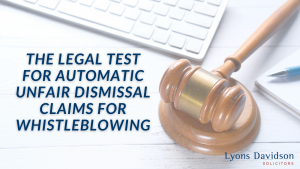
The legal Test for Automatic Unfair Dismissal claims for Whistleblowing
The Employment Appeal Tribunal’s decision in Secure Care UK Limited v Mr R Mott [2021] EA-2019-000977-AT has re-iterated the correct legal test to apply when determining whether a dismissal is automatically unfair for having made protected disclosures.
Facts
Mr Mott worked as a Logistics Manager for Secure Care UK Limited and he claimed under s103A Employment Rights Act 1996 (“ERA”) that he was unfairly dismissed due to having made protected disclosures. These protected disclosures related to wrongdoing such as breaches of a legal obligation or that the health and safety of a person was being endangered.
The Employment Tribunal found that three of Mott’s alleged nine protected disclosures amounted to qualifying protected disclosures. The qualifying protected disclosures included communications regarding:
- staff arrangements not being possible due to staff not having adequate rest breaks,
- cutting staff numbers meaning objectives could not be met; and
- when Mr Mott was instructed by the Respondent to inform a client that it had available cover for an assignment when it did not
Mr Mott alleged that patients’ and staff health and safety was in danger and the Respondent were in breach of the Care Quality Commission Regulations, health and safety laws and the Working Time Regulations.
The day after Mr Mott made this final qualifying protected disclosure, he was put at risk of redundancy and was dismissed over a month later for the potentially fair reason of redundancy.
The Tribunal Claim
At Tribunal, reference was made to the correct causation test in s103 ERA setting out that “The Claimant can only succeed in his claim for unfair dismissal if he can show that ‘the reason (or if more than one the principal reason) for the dismissal is that the employee has made a protected disclosure’.”
The Tribunal then considered that “…the case of Fecitt v NHS Manchester [2012] IRLR 64 makes it clear that there is a causal link if the protected disclosure materially influences in the sense of being more than a trivial influence, the employer’s treatment of the whistleblower.” The Tribunal concluded that Mr Mott’s protected disclosures had a material influence on his selection for redundancy and dismissal and therefore his automatic unfair dismissal claim was successful.
The Appeal
On appeal, the Respondent contended that the Employment Judge applied the wrong causation test, namely the s47B ERA claim test for subjecting a worker to a detriment on the ground that the worker had made a protected disclosure. The Tribunal should have applied the test under s103A ERA to an unfair dismissal claim. S103A requires that the protected disclosure is the sole or principal reason for the dismissal..
Sections 47B(1) and (2) of the ERA in relation ton Detriment sets out:
(1) A worker has the right not to be subjected to any detriment by any act, or any deliberate failure to act, by his employer done on the ground that the worker has made a protected disclosure.
(2) … this section does not apply where –
(a) the worker is an employee, and
(b) the detriment in question amounts to dismissal (within the meaning of Part X).”
Conclusion
The Employment Appeal Tribunal accepted these submissions and concluded that the Employment Tribunal Judge had applied the wrong test. The s103A ERA sole or principal reason test was the correct test to apply to the Claimant’s automatic unfair dismissal claim. The case has been remitted to the Tribunal.
It is important for potential claimants to note that, when drafting or pursuing claims for automatic unfair dismissal for making protected disclosures, the correct test is applied. This is a timely reminder that to be successful employees must be able to demonstrate that making the protected disclosures was the sole or principal reason for dismissal. It will not be sufficient to argue that making the protected disclosures influenced the decision to dismiss.



